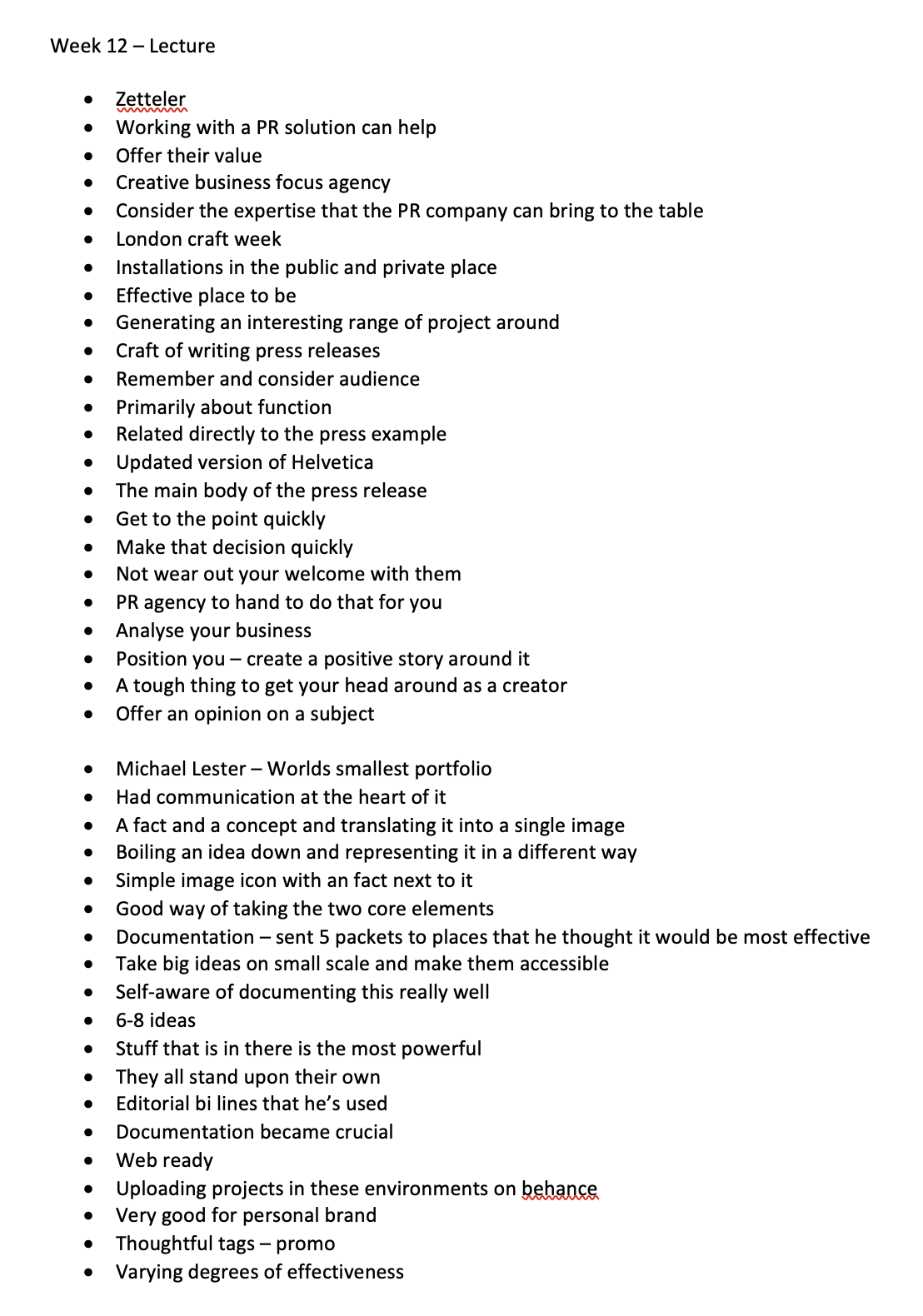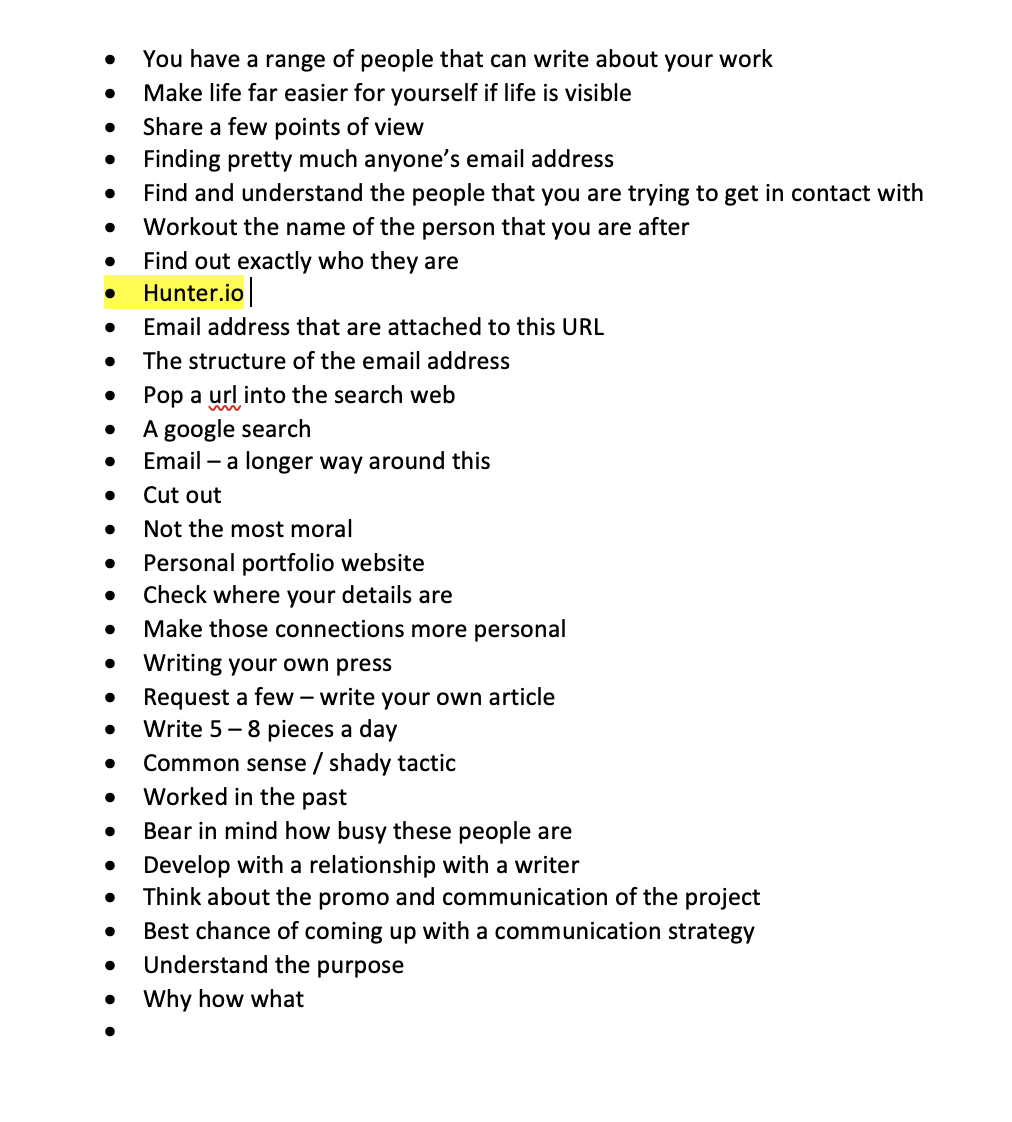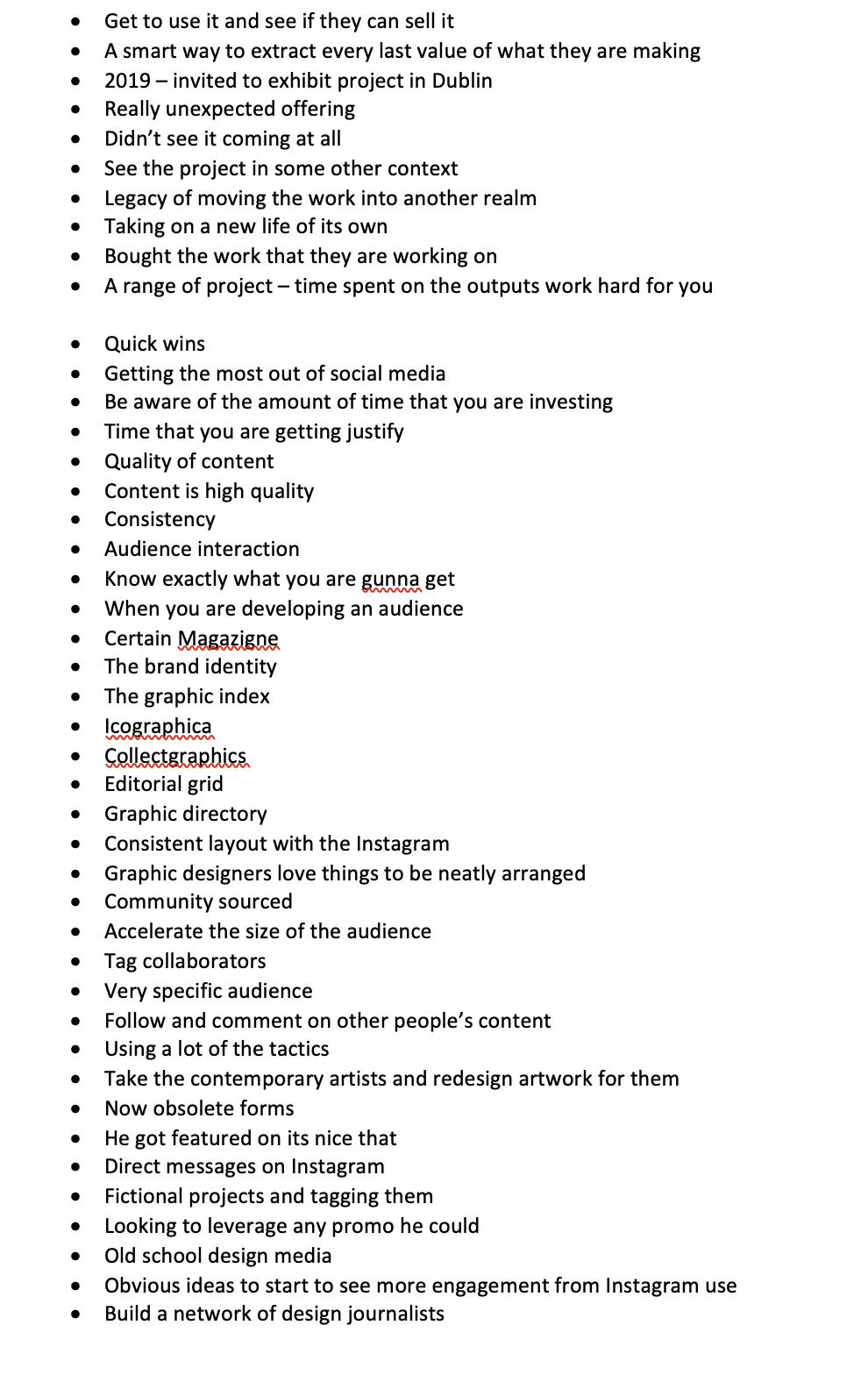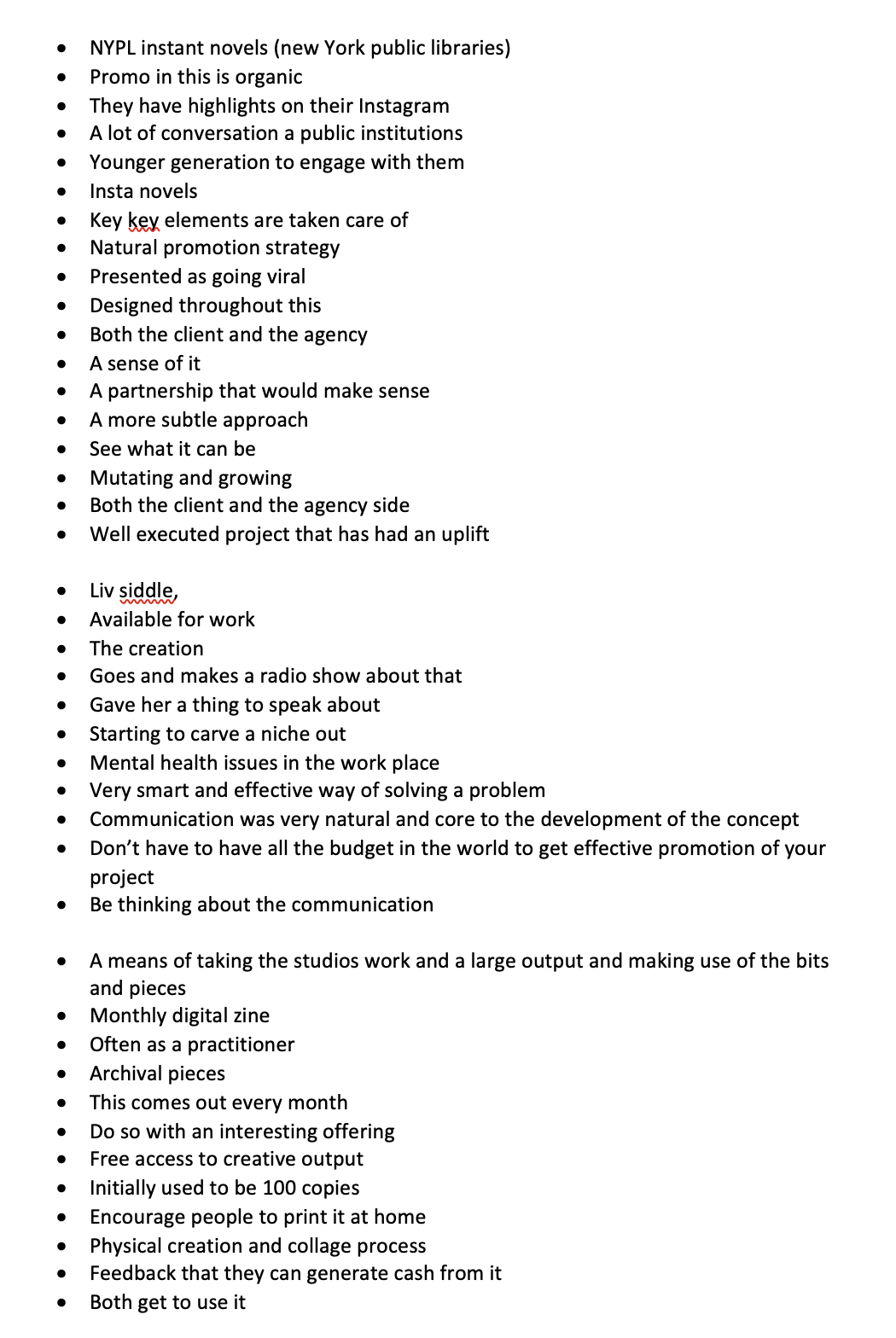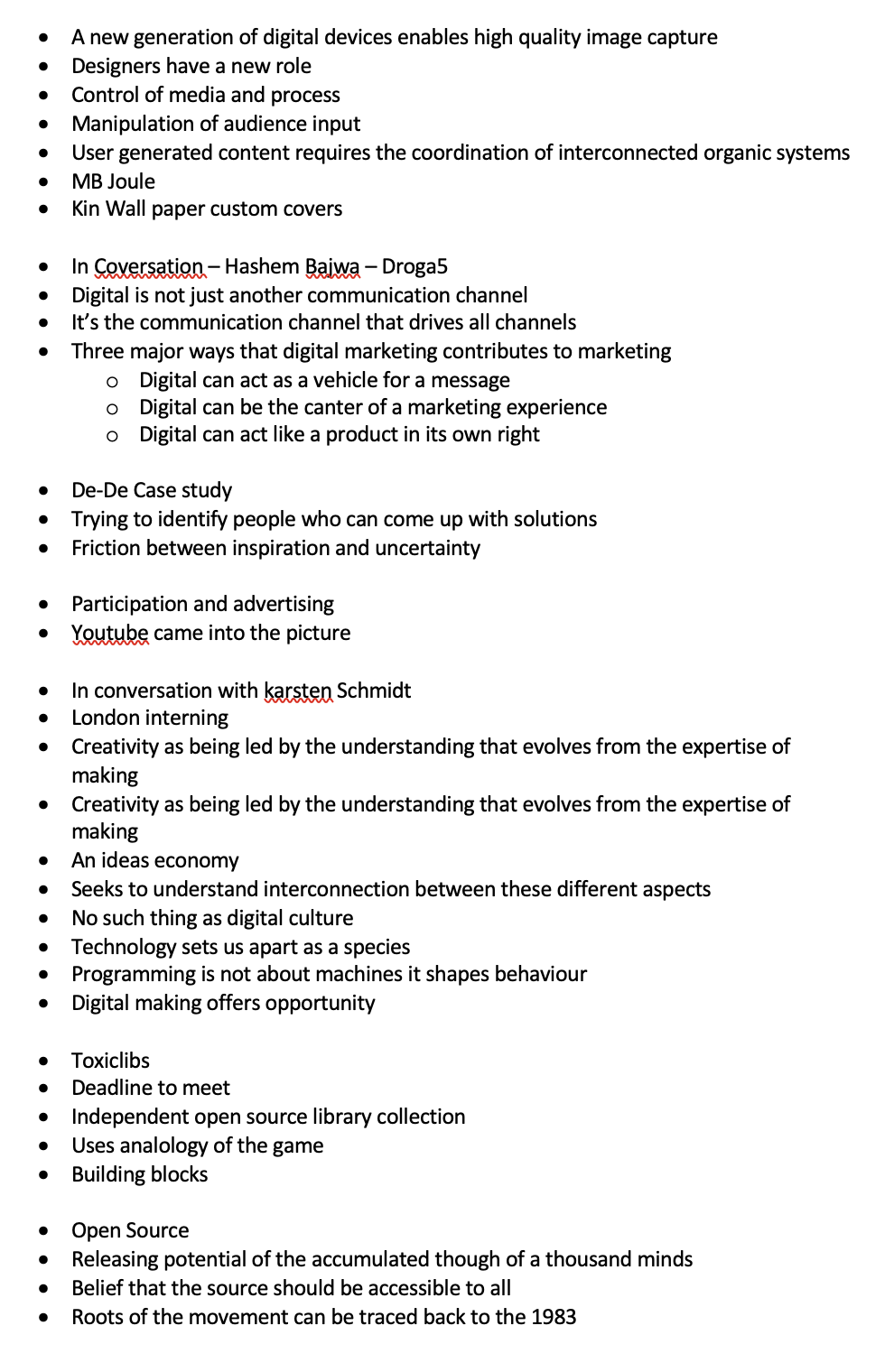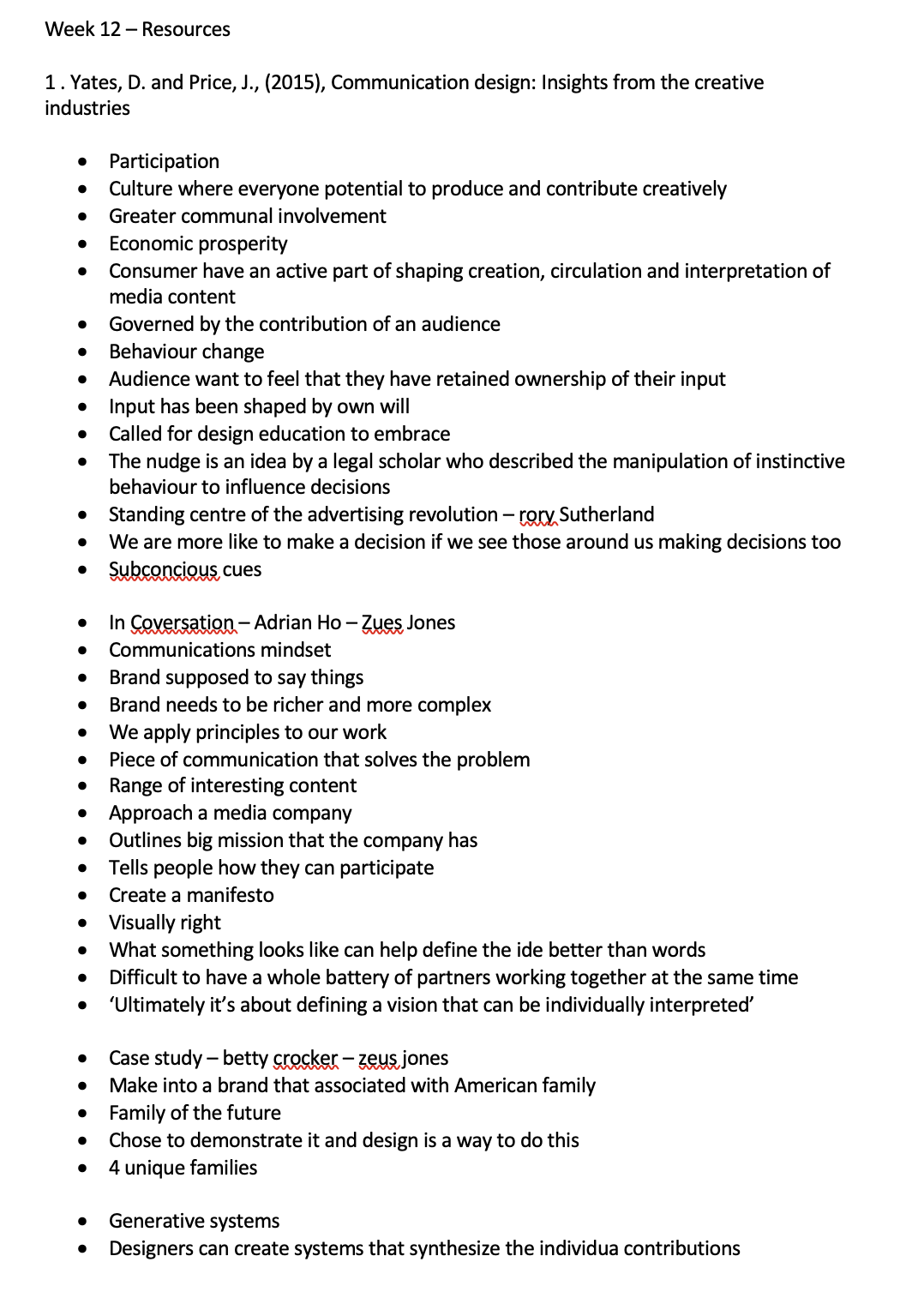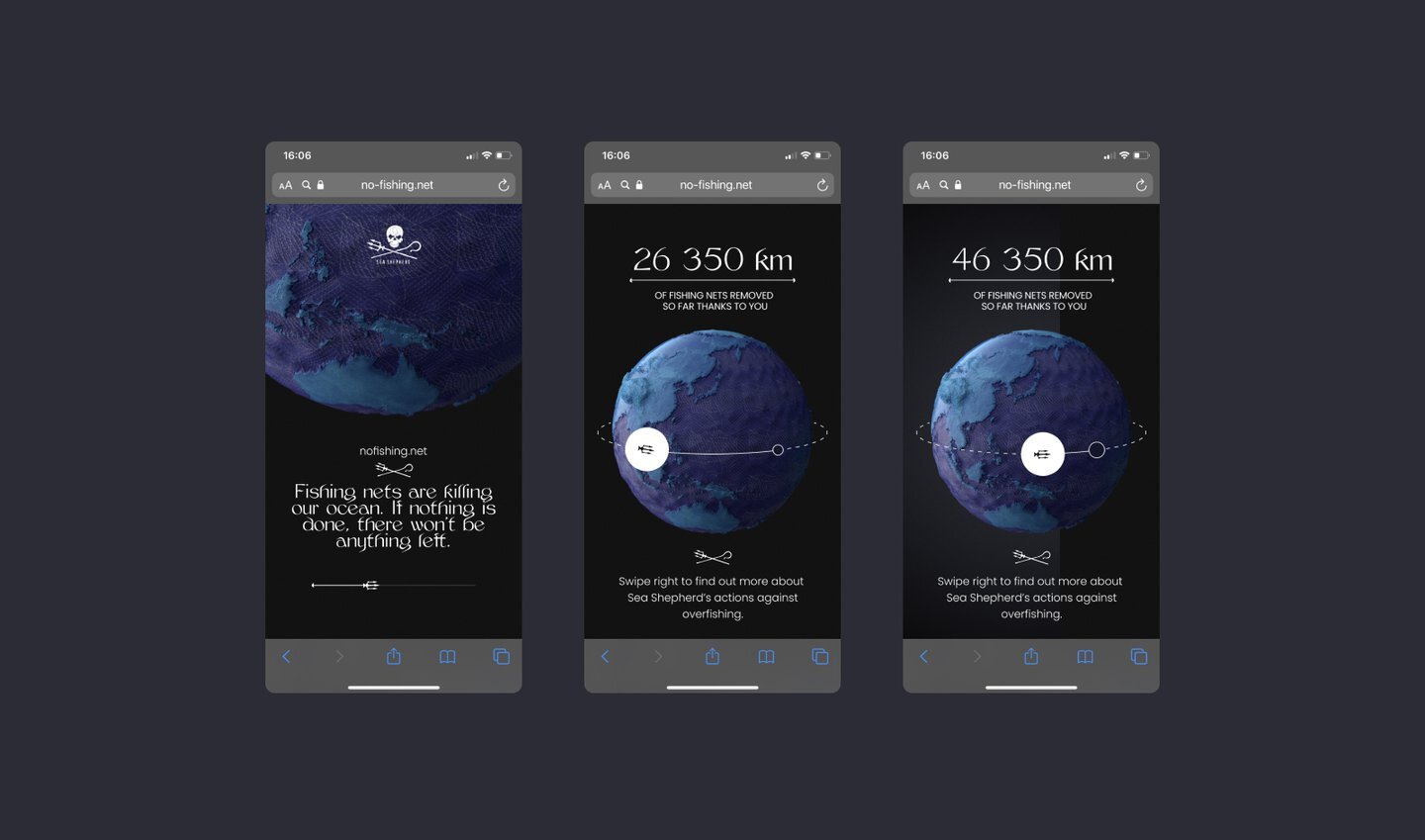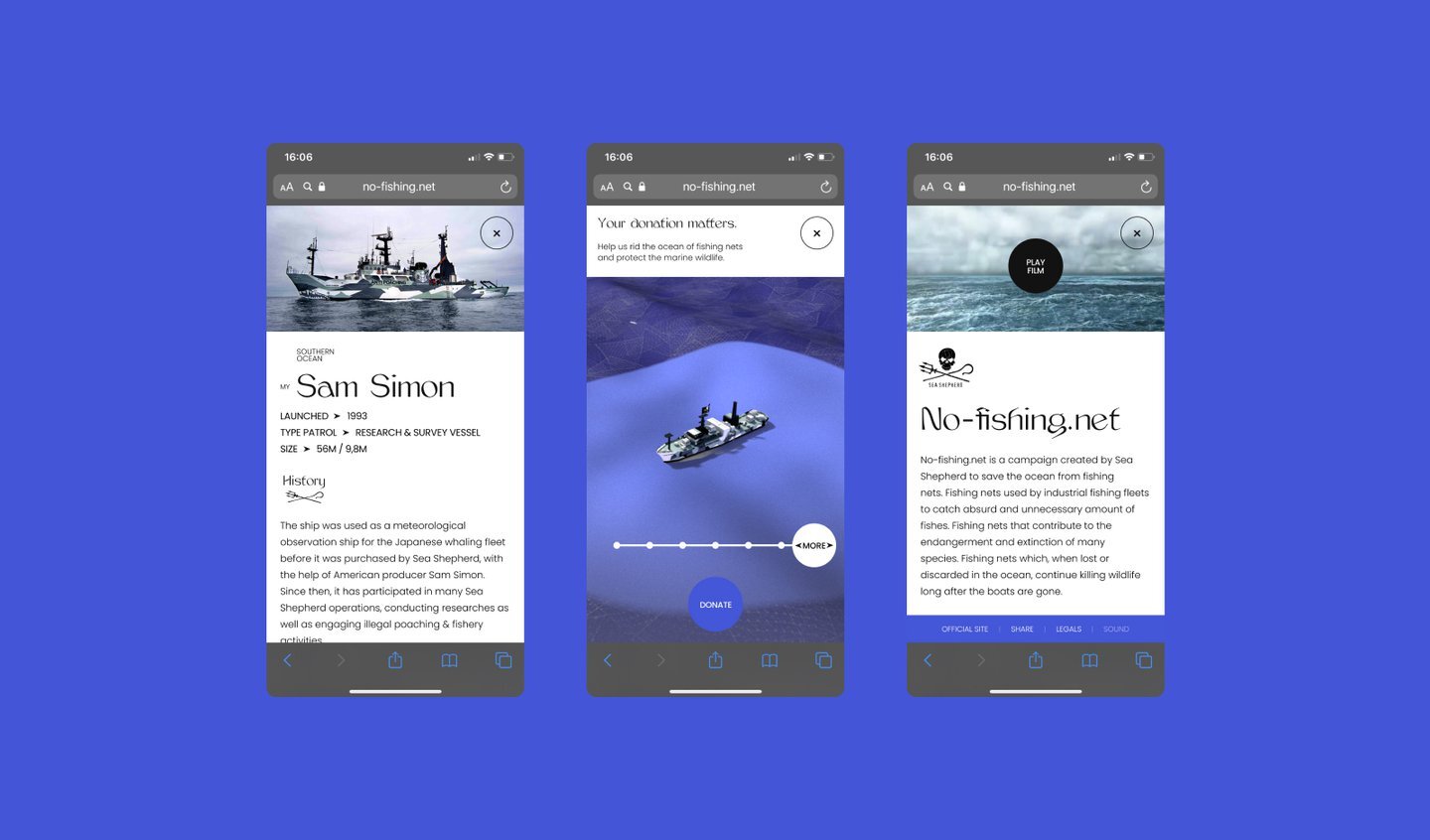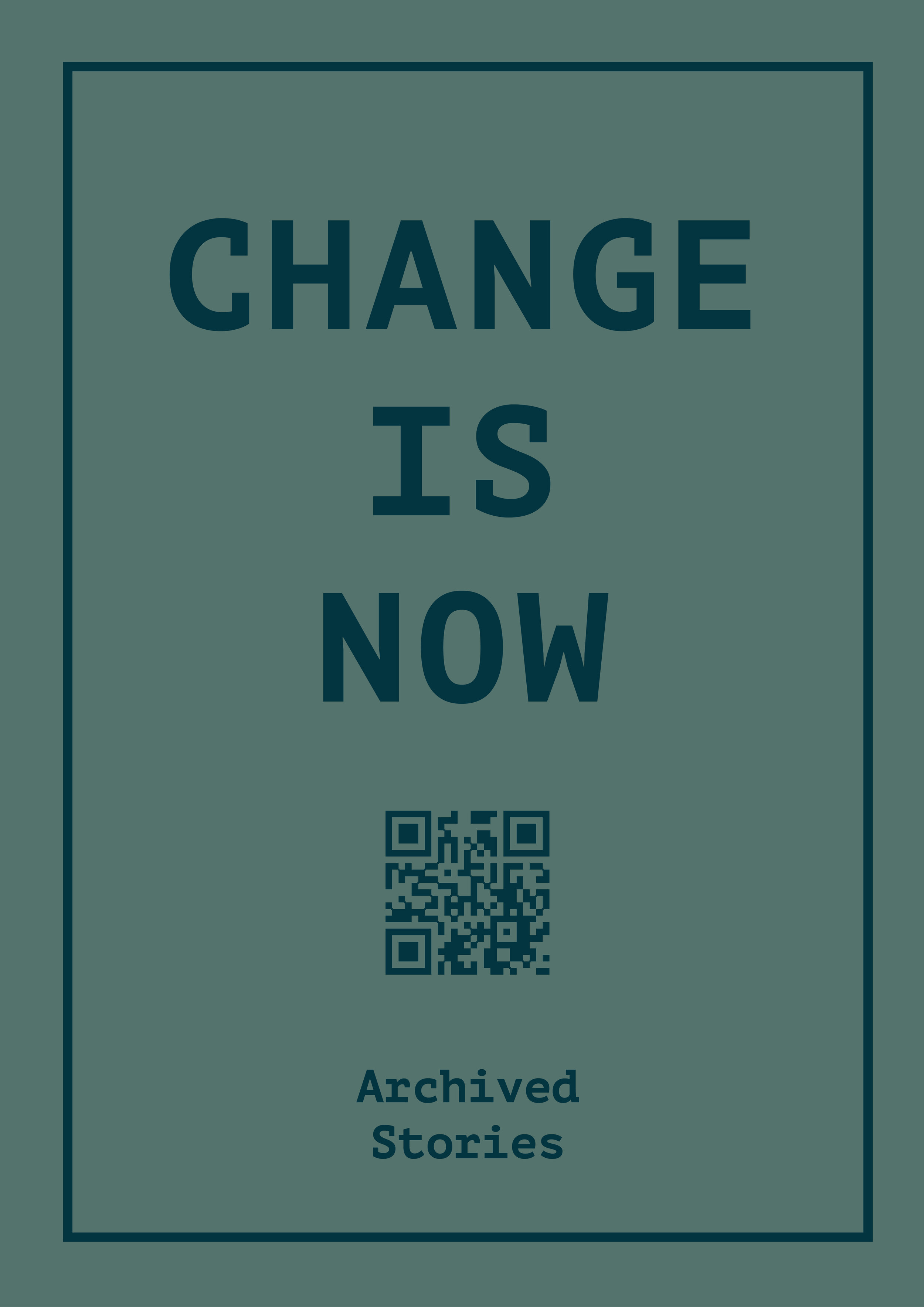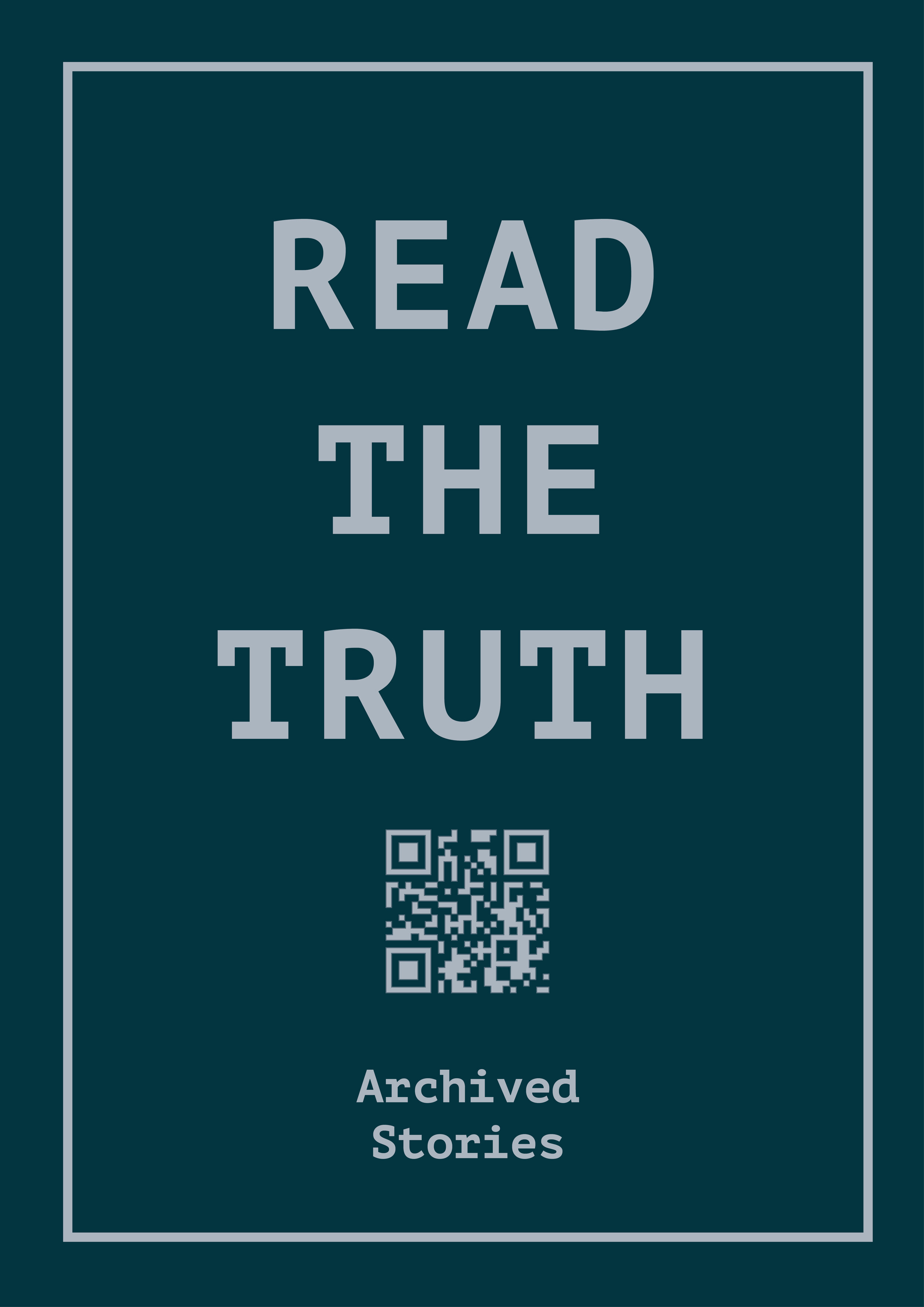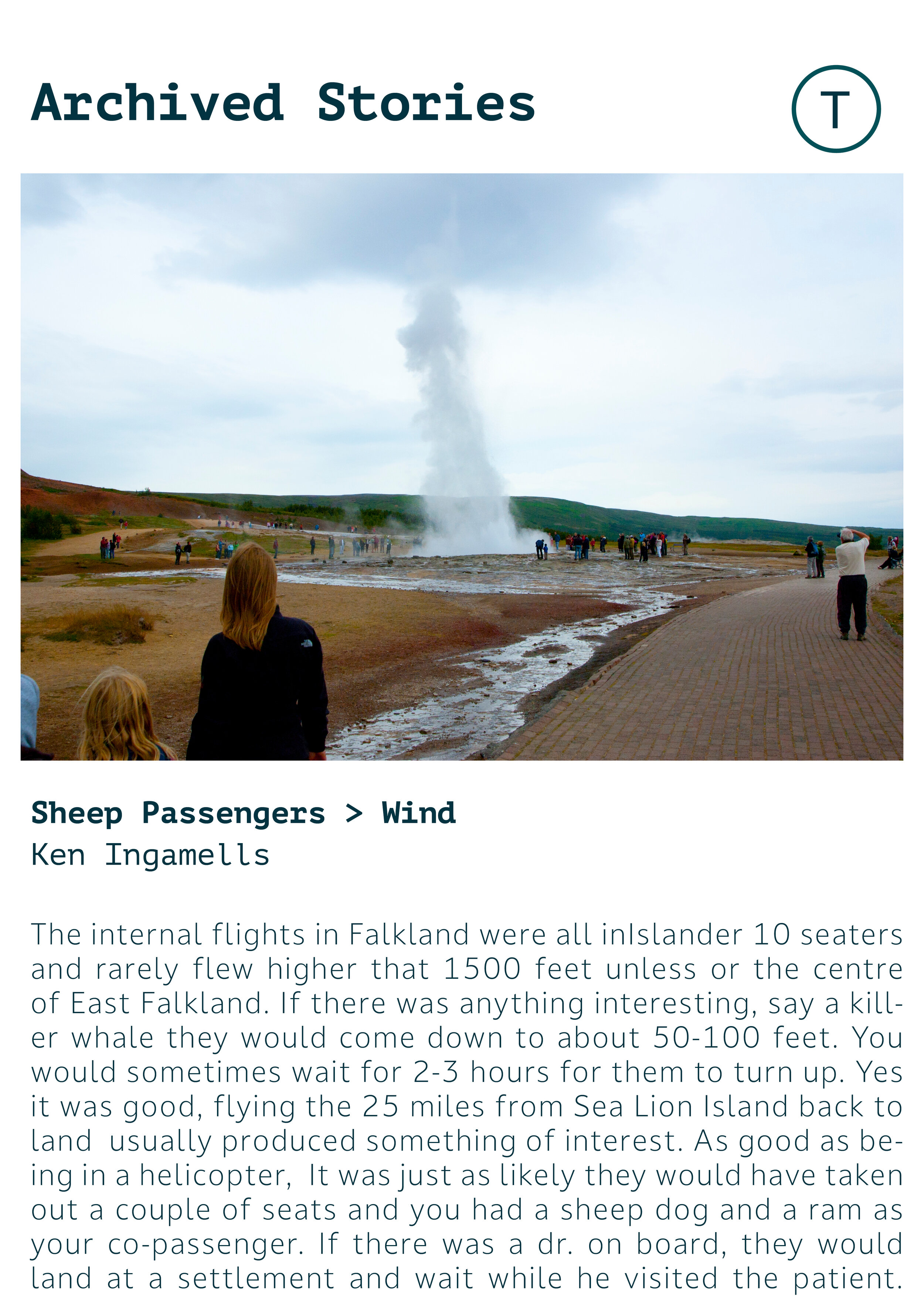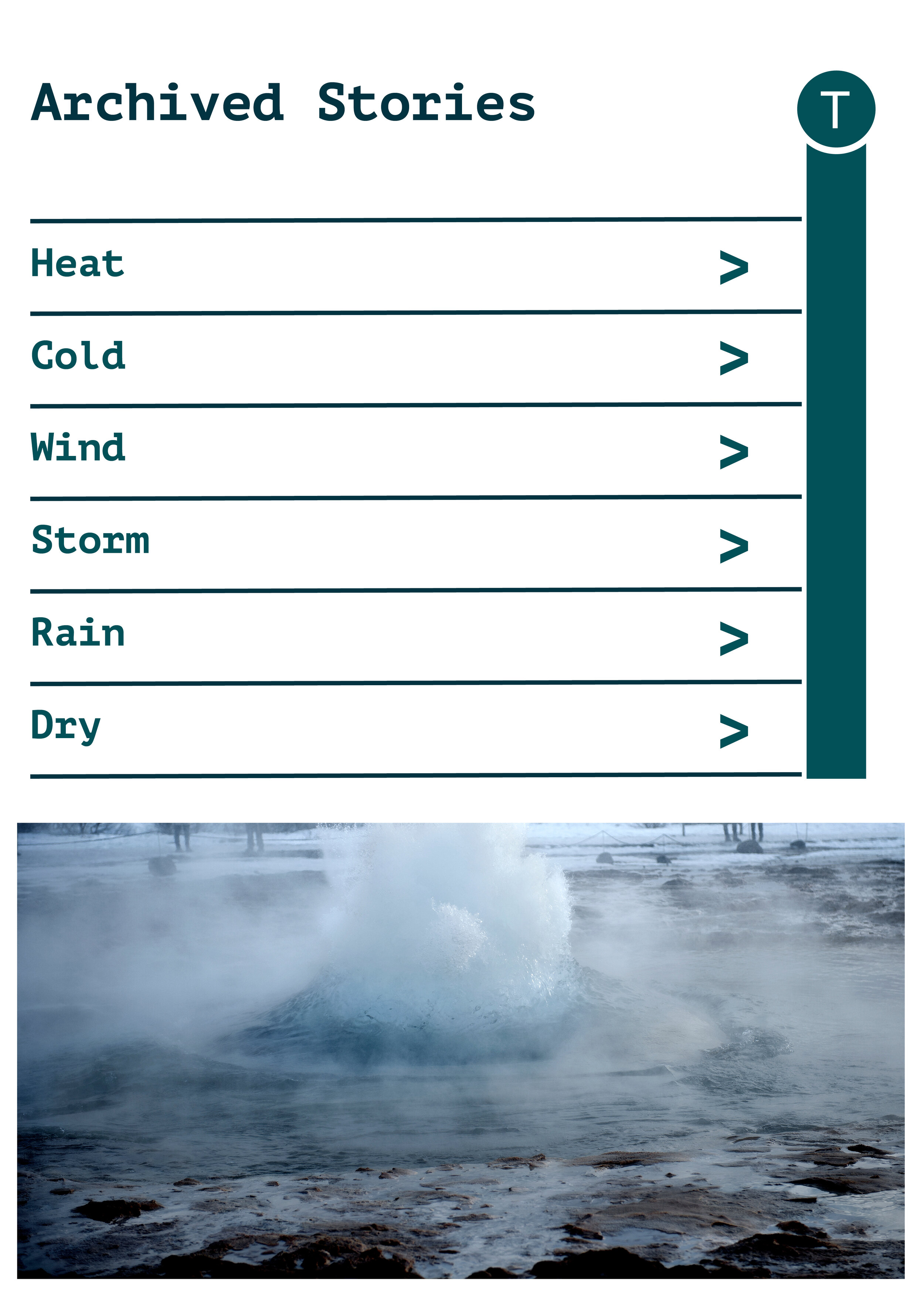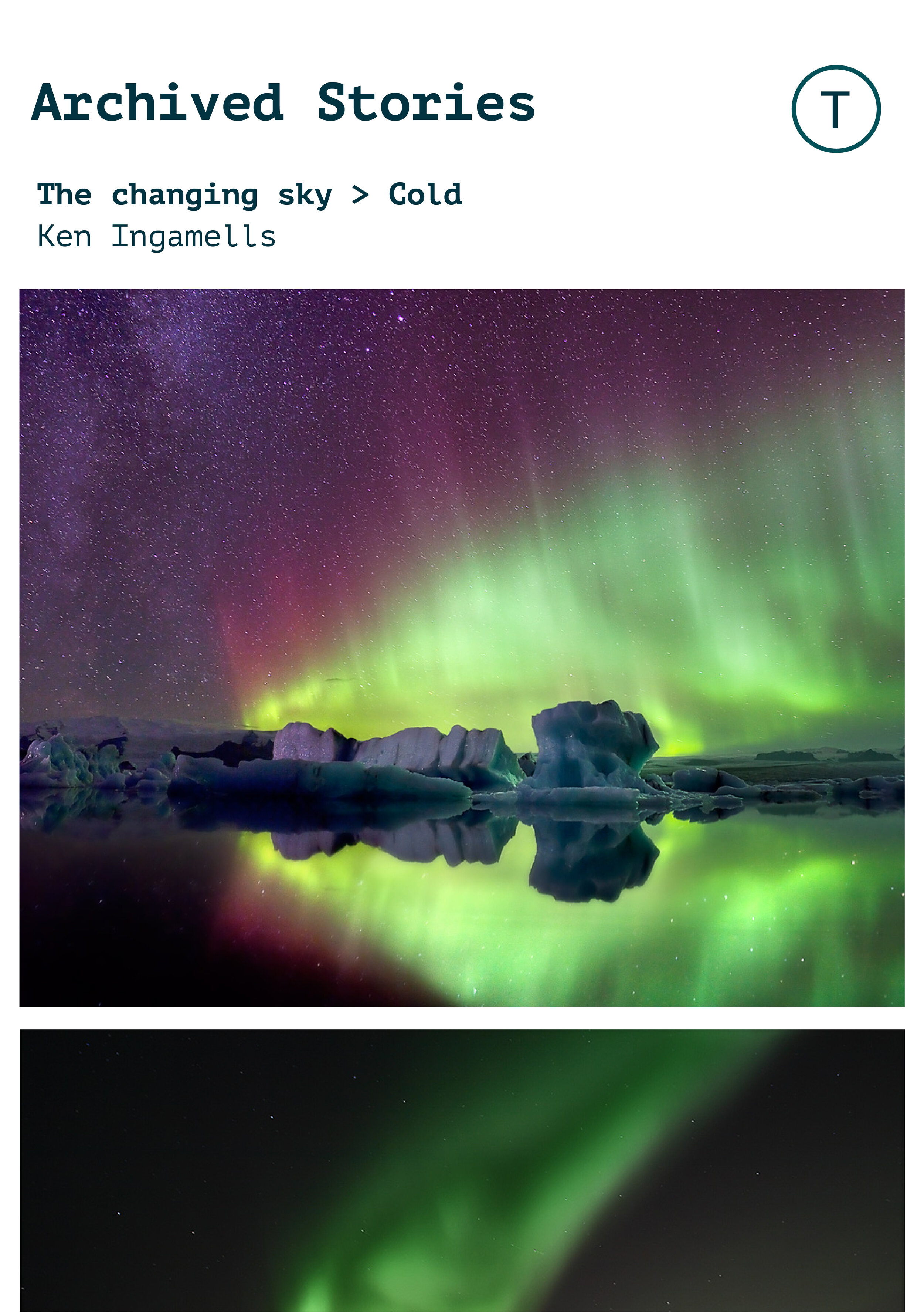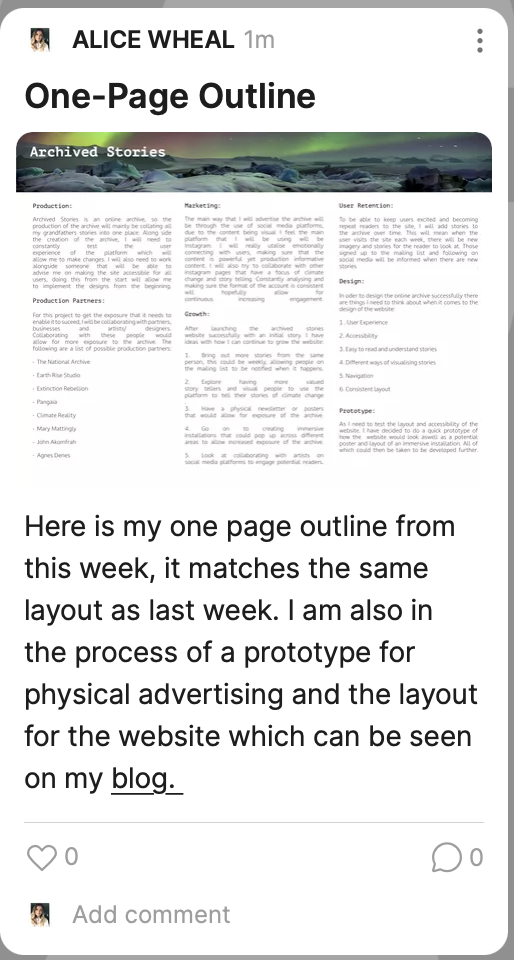Week Twelve
Lecture Notes:
Lecture Reflection:
https://www.awesomeinventions.com/michael-lester-worlds-smallest-portfolio/
I found this lecture really useful to learn about what other artists and designers had done to promote their designs and products. It was also really interesting to see how many people just sent their briefs to companies already written out. I was most taken by Micheal Lester, the worlds smallest portfolio and the really simple ideas that he had within the book itself. As well as this i feel that the advice that Alec Dudson gave at the end of the lecture to how to get peoples attention was really important as well as the hunter website which I will be using to get a job in the future.
Resource Notes:
Resource Reflection:
Resource this week was also interesting to learn about different projects that had been done. I am always interested in subconscious cues and decisions that people make when they are looking at different ideas. I think that consumers play such a huge role in how popular media content becomes in terms of engagement and conversations around it. I think theres a whole conversation around this about trends and getting the consumers attention.
Research:
Proposal – Developing Ideas and Designs for Launch of Authorial Artefact.
Research and investigate how designers and makers publicise their activities or products, and the media organisations and business platforms that will be a mouthpiece for the PR and marketing of your initiative.
After hearing about the super simple ways that Micheal Lester marketed himself and his skills, I wanted to do more research on how I would be able to market myself and my product for this week.
I found some useful articles on entreprenur.com and medium.
The Making of a PR Story
https://www.entrepreneur.com/article/83772
Within this article on entrepreneur.com, it talks about what a PR story really is and the 4 key steps that are the basics for making one. Within the article, it’s noted that a PR story is anything about your business, guaranteeing your businesses time in the limelight. The steps that are noted are super clear and helpful in looking at what to write for a PR story:
Step 1 - Determine your goals
Increase sales
Increase awareness of the business, brand or product
Become known as an expert
Enter a new market or industry
Change perceptions
Develop goodwill
Attract great employees
Attract investors and/or buyers
Step 2 - Choose your media targets
Base any selection from what the market that you want to aim at reads, watches and listens too.
Step 3 - Get creative
Brain storm story ideas that’ll intrigue the media.
Step 4 - Make the pitch
make the ideas appealing to the media.
“A one-page fact sheet/company overview
A biography of the yourself (the owner)
Several pitches from the ideas that'll appeal to each media outlet”
Always phone the company first before emailing the pitch over
Secrets Behind the most successful PR campaign
https://www.entrepreneur.com/article/368868
Within this article on entrepreneur.com by Imran Tariq, It talks about how to make your PR successful after learning about how to write one in the previous article. It talks about the following things, creating a shock appeal with a heartfelt message. I agree with this in some ways as connecting with the customer emotionally does tend to get the customer to engage with the product more. The next point within the article was problem solving, this related to how much the customer sees it as solving a problem in their lives. The last point within the article which i thought was the most important point, was viral consumer participation with social impact so doing different campaigns that would allow people to engage with the brand and the story. I feel if i was then relating this back to my artefact, having people get engaged with different awareness projects would be really great its just getting people interested.
Offline Strategies to promote your business
https://analucianovak.medium.com/offline-marketing-strategies-to-promote-your-website-dc3367ae623a
Due to a lot of things being online, I feel this article was really useful in listing things that you are able to do to promote your business offline. Although alot of them dont relate to my artefact at the moment, they may relate to my artefact in the future. The article lists the following:
Fundraisers
Charity Functions
Business Shows
Seminars
Direct Mailing Advertising
Local Business Organisations
From this, I feel that I could do direct mailing advertising or a physical news letter that could allow the exposure of my artefact in the future.
How to create a social media marketing plan
https://www.entrepreneur.com/article/249306#!
Within this article by entrepreneur.com by Kevan Lee, It talks about how overwhelming the social media world can be which I completely agree with especially if you are looking at it from a business perspective. The social media marketing plan is seen as an infographic but is seen as the following steps:
Step 1: Choose your social networks
Step 2: Fill out your profiles completely
Step 3: Find your voice and tone
Step 4: Pick your posting strategy
Step 5: Analyze and test
Step 6: Automate and engage
It goes into a lot of detail into each of the steps but I felt that the basic outline of the steps was helpful enough aswell as the infographic.
Designers Publicising themselves
Marylou Faure
https://www.itsnicethat.com/articles/nicer-tuesdays-august-2020-marylou-faure-illustration-150920
Within this presentation from Marylou Faure with Nicer Tuesdays, Marylou shared her freelance illustrator work. She mainly works on digital things but decided to also start working on physical objects and painting. She talks about how if she isn’t getting the work she wants then she goes and finds it. The main part of the lecture that is relevant fort this week, was looking at how to promote yourself as a designer. She mentioned how hard it is to promote yourself but just putting yourself out there with your work means theres most likely to be positive comments as long as its something you like and admire. I feel this really relates to the reasoning behind the artefacts this week. We are designing something that we are interested in and so hopefully putting ourself out there, there will be a positive comment.
My Artefact
Designing with a Narrative
https://www.itsnicethat.com/articles/double-click-march-makemepulse-digital-300321
This is an interview with the studio of make me pulse which is a global interactive design studio, they talk about how to create digital designs with an overarching narrative in mind. Nicolas Rajabaly, talks about how story telling experiences are one of the ways to engage people within which allow people to connect with the emotion and information that they are reading. They designed the no-fishing.net site which has alot of infographics. She also talks about how interactive experience tend to lead to more change within the consumer as they are able to visualise it. They want people to travel to the place that they are talking about which is how i want my artefact to feel when someone is reading it. The following is my favourite quote from the article as well as some advice going forward, which I feel is relevant.
“When a project is driven by passion and uniqueness, people feel this, the passion and the love put into it is passed on.
“Do what you love” is a good approach. Try to understand what you truly like and what makes you feel things. This will help you find your way of creating unique experiences instead of doing another piece of a long series of trendy websites that will be irrelevant in a year or so.
A last note for web designers: Look for inspiration outside of the digital world, get inspired by movies, video games, music, events, nature and whatever things you enjoy in life, there is a good chance you might find a valuable creative angle that people will definitely respond and relate to.”
Marketing Tricks
Within this other article on creative boom with Katy Cowan about how to get people to come to the website, I feel this is something that i will struggle with especially if the archive isn’t that well known yet.
Lots of juicy content
Have key words within your website that would allow it to be found on a google search. It also talks about blogging a lot but I didn’t find this particularly useful.
Share content on social media
Using an automation app to get the posts and content that you need on social media. But also analyse what isn’t working and tweak it.
Extend reach through PR
This is what I did look at earlier in the week
Using other networks to get peoples attention
I hadn’t thought of this one due to thinking the main marketing platform is instagram but there are other websites that would be useful too.
User Retention
How do you engage the user initially but keep them coming back for more.
Website Design
https://www.creativeboom.com/tips/six-most-overlooked-things-when-building-your-own-website/
Within this article on creative boom with Katy Cowan, goes into the details of creating a website and things that sometimes are overlooked in the creation. This article was super helpful in outlining the key things to include and focus on within the website.
Great User Experience and Navigation
State who you are and what you do by keeping it simple making it easy to look around the website but also call people to engage.
2. Relevant contact information.
3. Proof that your good (I feel this one isn’t relevant to the artefact but still useful to know)
4. Spelling and grammer (Something i always struggle with so this is really important to remember)
5. Carrying out user testing and continually improving
This section had some useful pages that were on budget for testing with google analytics and social media being one of them.
Accessibility
https://eyeondesign.aiga.org/in-web-design-accessibility-shouldnt-be-an-afterthought/
After accessibility being mentioned within my research last week, I wanted to find out how to incorporate it within my website from the start. Within the article, it talks about how to make sure that you are including both people from the community from the start of the project to make sure its accessible for everyone. It also talks about different things that you can put into a website but one content designer says not to rely on automated testing tools. Theres also a super helpful link that allows designers to connect with people from the community in order to collaborate on projects.
Weekly Challenge:
How do you build, promote and tell the story of your new product?
Ensure you utilise analogue and digital craft to explore the production requirements of your artefact.
At this stage we only require a prototype, a one-page outline or short video of next steps, and even production partners to support any future development. Please remember, prototyping exists to demonstrate the potential and functionality of your output – there are a number of methods / software tools to help make shortcuts so you can give a sense of the bigger picture.
This is about expediency, fast iteration, testing and development to help an audience or business partner to see the potential of your proposition.
This could potentially be picked up again in your final MA project.
From the research above, I feel there are some areas that would help me to decide and plan things.
Promotion of the business (Offline marketing)
From the medium article, I found it useful to look at different ways that I could promote my website away from the internet. From this I thought of two different ways that I could do this, taking inspiration from Rebellion Extinction, they advertise themselves through super simple logo posters and protests which is shared through social media. I feel if I was to come up with something similar with a logo design that would allow the word to be spread as well as when people visit the archive itself they will then be able to sign up to newsletter that could be physically posted to them in order to get that physical interaction.
Social Media
Social media was mentioned within majority of the articles this week about making sure the engage with the users and viewers through a platform that would get their attention. Due to the visual aspect of my project I thought it was important to use Instagram as my main social media platform to advertise the artefact. Sharing content on Instagram at the peak time of 5-6pm possibly collaborating with other Instagram accounts would allow the artefact to get people’s attention.
User Retention
As mentioned within the above, promotion of the business, getting people to engage by filling in their details when they arrive at the archive would allow for more user retention by sending physical. Another way of user retention that is mentioned within the article by Katy Cowan is how to get people to keep coming back for more, for this I think there could be an idea in releasing content to the website. Also when expanding the website in the future, having more than one person talk their stories on the website would also allow for people to come back.
Website Design
The website design is really crucial part of the archive as this is what will be bringing people in from where ever they have found us from. It need to be clear and easy to navigate as well as being accessible for all users and ages. Within the Katy Cowan article, it talks about making sure that you are constantly testing and improving the website. Which I feel will be the hardest part to make sure that its constantly being tested and improved. I also want to make sure that the website will be accessible from the start so working with someone to make sure that this happens will also be really important.
Then putting the above information in a document like last week:
Production
Archived Stories is an online archive, so the production of the archive will mainly be collating all my grandfathers stories into one place. Along side the creation of the archive, I will need to constantly test the user experience of the platform which will allow me to make changes. I will also need to work alongside someone that will be able to advise me on making the site accessible for all users, doing this from the start will allow me to implement the designs from the beginning.
Production Partners
For this project to get the exposure that it needs to enable it to suceed, I will be collaborating with partners, businesses and artists/ designers. Collaborating with these people would allow for more exposure to the archive. The following are a list of possible production partners:
- The National Archive
- Earth Rise Studio
- Extinction Rebellion
- Pangaia
- Climate Reality
- Mary Mattingly
- John Akomfrah
- Agnes Denes
Marketing
The main way that I will advertise the archive will be through the use of social media platforms, due to the content being visual I feel the main platform that I will be using will be Instagram. I will really utalise emotionally connecting with users, making sure that the content is powerful yet production informative content. I will also try to collaborate with other instagram pages that have a focus of climate change and story telling. Constantly analysing and making sure the format of the account is consistent will hopefully allow for continuous increasing engagement.
Growth
After launching the archive website successfully with an initial story. I have ideas with how I can continue to grow the website:
1. Bring out more stories from the same person, this could be weekly, allowing people on the mailing list to be notified when it happens.
2. Explore having more valued story tellers and visual people to use the platform to tell their stories of climate change.
3. Have a physical newsletter or posters that would allow for exposure of the archive.
4. Go on to creating immersive installations that could pop up across different areas to allow increased exposure of the archive.
5. Look at collaborating with artists on social media platforms to engage potential readers.
Design
In oder to design the online archive successfully there are things I need to think about when it comes to the design of the website:
1 . User Experience
2. Accessibility
3. Easy to read and understand stories
4. Different ways of visualising stories
5. Navigation
6. Consistent layout
User Retention:
To be able to keep users excited and becoming repeat readers to the site, I will add stories to the archive over time. This will mean when the user visits the site each week, there will be new imagery and stories for the reader to look at. Those signed up to the mailing list and following on social media will be informed when there are new stories.
Prototype
As I need to test the layout and accessibility of the website. I have decided to do a quick prototype of how the website would look aswell as a potential poster. All of which could then be taken to be developed further.
Prototype Posters:
As a way of getting more attention to the site, I feel I could place posters around different cities in the UK that extinction rebellion has done so well. Instead of using paper, I would like to use an eco friendly option that will eventually wash away and not harm the planet. I have done some mock ups of the posters below:
Website:
I decided to do a prototype of how the wesbite might look with the layout. I wanted the different weathers to be a way of navigating across the website, there would also be a section on climate change within each of the sections and possibly subsections.
Weekly Reflection:
This week has really helped me to see how important marketing and promoting is for self initiated projects. From the examples that were spoken about within the lecture, the New York Library putting classic stories within their instagram account as well as Micheal Lester’s Smallest portfolio were great examples of how to put things out to people to make a change. I felt this was a helpful stepping stone in the right direction for researching different methods of promotion and marketing products. Through the research from this week, I discovered ways to promote offline aswell as how to keep users coming back to the site. Marketing also goes hand in hand with how easy the website is for the user to navigate around and the social media to get them there.
I took all of these points to create the PDF along with the multiple prototypes to show my ideas across the project which I can hopefully take forward to develop further in the future.
